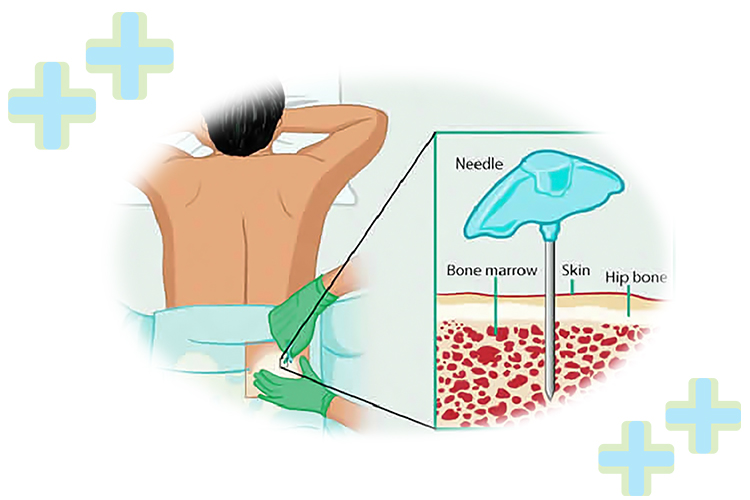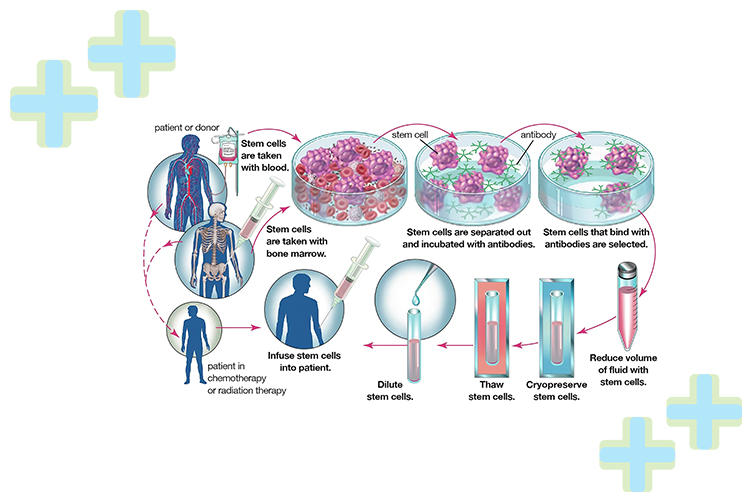Bone marrow transplant
What Is Bone Marrow Transplant?
Bone marrow transplant (BMT), also known as hematopoietic stem cell transplant (HSCT), is a medical procedure in which damaged or diseased bone marrow is replaced with healthy bone marrow stem cells.

What Are the Types of Bone Marrow Transplant?
Autologous bone marrow transplant and allogeneic bone marrow transplant happen to be the 2 major types. Autologous bone marrow transplant involves collecting a patient’s own healthy bone marrow stem cells and storing them before they receive high-dose chemotherapy or radiation therapy. After the chemotherapy or radiation therapy, the stored stem cells are infused back into the patient’s body to replace the damaged or destroyed bone marrow. In contrast, allogeneic bone marrow transplant involves using bone marrow stem cells from a donor, typically a sibling or a matched unrelated donor.
Why Is Bone Marrow Transplant Done?
Bone marrow transplant is done to treat certain cancers, such as leukaemia, lymphoma, and multiple myeloma, as well as certain non-cancerous conditions, such as sickle cell anaemia, aplastic anaemia, and some immune system disorders. The goal of the procedure is to replace the patient’s diseased or damaged bone marrow with healthy bone marrow stem cells, which can then produce new, healthy blood cells.

Any Risks?
Bone marrow transplant is a complex and risky procedure that can have serious complications, including infections, bleeding, and graft-versus-host disease (GVHD), in which the donor cells attack the recipient’s body. Therefore, careful preparation and monitoring are necessary to minimize the risks.
How to Prepare for a Bone Marrow Transplant?
To prepare for a bone marrow transplant, patients undergo a series of tests and procedures to assess their overall health and determine the best course of treatment. This may include blood tests, imaging scans, and a bone marrow biopsy to evaluate the patient’s bone marrow function and disease status.

What to Expect before Bone Marrow Transplant?
Before the transplant, patients undergo conditioning therapy, which may involve chemotherapy, radiation therapy, or a combination of both, to destroy the diseased or damaged bone marrow cells and prepare the body to receive the new stem cells. After the conditioning therapy, the patient receives the bone marrow stem cells through a vein, much like a blood transfusion.
What to Expect during Bone Marrow Transplant?
During the transplant, patients may experience side effects such as nausea, vomiting, fatigue, and fever. They are closely monitored for complications such as infections, bleeding, and GVHD, and receive supportive care as needed.
What to Expect after Bone Marrow Transplant?
After the transplant, patients typically spend several weeks or months in the hospital to recover and receive follow-up care. They are monitored closely for complications and receive medications to prevent infection and GVHD.
Travel with Health Trawell for Bone Marrow Transplant
Travelling to another country for Bone Marrow Transplant could be quite a challenge if you are not escorted by the right people. So, here’s Health Trawell at your service! They can guide you throughout the process, gather every minute detail for you, and assist you thoroughly to get you the best medical service in their home country.
OUR SERVICES

Cosmetic Surgery

Spine Surgery

Organ Transplant

Orthopedic Surgery

Gynecology Infertility

Ophthalmology

Neurosurgery
Cardiology
YOUR GATEWAY TO HEALTH

